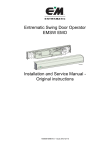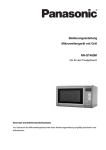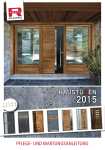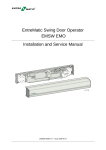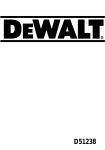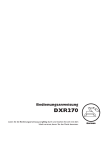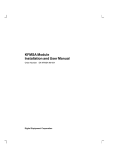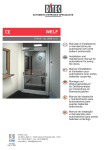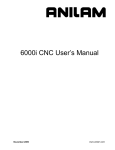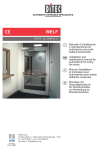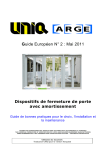Download Entrematic Swing Door Operator EMSW Installation - Ruko e-shop
Transcript
1003870 SW TB2 1 2 3 4 D TB2, ALLCLTABS1SAN 2 SUPPLY MAX. 24 V 0 V DC 24 V DC MVI Impulse Outer Impulse Lock 24 V DC 0 V DC Key Impulse Kill MVI H.O.T TB2 4 H.O.T 3 Motor control 0 V DC "Slave" 24 V DC 2 Kill jumper MVI N.O. / N.C. MVI Open Lock / Door Lock w. / w.o. power Lock time 1.5 s / until closing Slave delay off / on Master / Slave Push & Go 1 ON Opening Delay LK HSC LSC HSC LSC LK 701448 LSO HSO LSO HSO 701500 Entrematic Swing Door Operator EMSW Ruko DA501 14 1 1213 9 101 7 8 5 6 1 2 3 4 5 6 7 8 TM Installation and Service Manual Original instructions 1004291-EMEI-5.0 – Issue 2012-01-26 © All rights in and to this material are the sole property of Ditec Entrematic Nordic AB. Copying, scanning, alterations or modifications are expressly forbidden without the prior written consent of Ditec Entrematic Nordic AB. Rights reserved for changes without prior notice. Backtrack information: folder: Library, version: a317, date: 2012-01-26, time: 07:22:37, state: Working CONTENTS CONTENTS 1 Revision ............................................................................................................................... 4 2 Important information ........................................................................................................... 5 3 Technical specifications ....................................................................................................... 7 4 How the EMSW works ......................................................................................................... 9 5 Models ................................................................................................................................. 14 6 Part identification & Accessories ......................................................................................... 16 7 Pre-Installation ..................................................................................................................... 21 8 Mechanical installation ......................................................................................................... 24 9 Electrical connection ............................................................................................................ 39 10 Start-Up ............................................................................................................................... 45 11 Cover ................................................................................................................................... 48 12 Signage ................................................................................................................................ 50 13 Installation on fire doors ....................................................................................................... 51 14 Installation and adjustments - Low Energy Operator ........................................................... 56 15 Installation instructions for Accessories ............................................................................... 60 16 Troubleshooting ................................................................................................................... 66 17 Maintenance plan ................................................................................................................ 67 1004291-EMEI-5.0 Issue 2012-01-26 3 1 Revision 1 Revision Following pages have been revised: Page Revision 4.0 → 5.0 New illustration on the front page 4 5 Module texts updated 7 Technical specification updated 11 10 sec changed to 14 sec. 12 Error messages added 45 New sentence 21 New chapter 51 Text updates, new sub section, new illustration 15, 40, 41, 42, 43, 47, 50 Illustrations updated 18 New cable kit 66 Troubleshooting about flashing LED added 55 Illustration updated 53 New section 18 Cable inlet added 18 Middle piece kit added 49 Middle piece cover added 27 Section updated. New installation instructions. 44 New section Issue 2012-01-26 1004291-EMEI-5.0 2 Important information 2 Important information Failure to observe the information in this manual may result in personal injury or damage to equipment. Save these instructions for future reference. 2.1 Intended use The door is designed to offer continuous use, a high degree of safety and maximum lifetime. The Entrematic EMSW is an automatic swing door operator developed to facilitate entrances to buildings and within buildings through swing doors. The EMSW is an electrohydraulic operator approved for fire door applications. It is to be installed indoors where it is suitable for almost all types of external and internal swing doors. This widely-used operator can be found on applications ranging from handicapped-access in private homes to high-traffic retail operations. Door operator used in escape routes shall be installed so that the door opens in the escape direction unless the system allows breakout in this direction. These operators shall be connected to a fire alarm system, see section 10.1, 13.2 or 13.3. The motor, oil pump and hydraulic unit are combined into a compact unit mounted alongside the control unit within the cover. The operator is connected to the door leaf with a range of different arm systems. For use see User manual 1004131. 2.2 Safety precautions Do not climb on door parts. Do not let children play with the door or the fixed controls. Be sure to complete the site acceptance test before taking the door into operation, see PRA0007. To avoid bodily injury, material damage and malfunction of the product, the instructions contained in this manual must be strictly observed during installation, adjustment, repairs and service etc. Training is needed to carry out these tasks safely. Only Entrematic-trained technicians should be allowed to carry out these operations. 2.3 Electronic equipment reception interference The equipment complies with the European EMC directive (US market FCC Part 15), provided installed according to Installation and Service manual. The equipment may generate and use radio frequency energy and if not installed and used properly, it may cause interference to radio, television reception or other radio frequency type systems. If other equipment does not fully comply with immunity requirements interference may occur. However, there is no guarantee that interference will not occur in a particular installation. If this equipment does cause interference to radio or television reception, which can be determined by turning the equipment off and on, the user is encouraged to try to correct the interference by one or more of the following measures: • Re-orient the receiving antenna. 1004291-EMEI-5.0 Issue 2012-01-26 5 2 Important information • Relocate the receiver with respect to the equipment. • Move the receiver away from the equipment. • Plug the receiver into a different outlet so that equipment and receiver are on different branch circuits. • Check that protective earth (PE) is connected. If necessary, the user should consult the dealer or an experienced electronic technician for additional suggestions. 2.4 Environmental requirements Entrematic products are equipped with electronics and may also be equipped with batteries containing materials which are hazardous to the environment. Remove this material from the operator before it is scrapped and make sure that it is disposed of properly as was done with the packaging. This manual contains the necessary details and instructions for the installation, maintenance and service of the Swing Door Operator Entrematic EMSW. 6 Issue 2012-01-26 1004291-EMEI-5.0 3 Technical specifications 3 Technical specifications Ensure that the door operator with technical specification below is suitable for the installation. Manufacturer: Ditec Entrematic Nordic AB Address: Lodjursgatan 2, SE-261 25 Landskrona, Sweden Type: EMSW Mains power supply: 230 V AC ±10%, 50 Hz, mains fuse max 10A Note! The mains power supply shall be installed with protection and an all-pole mains switch with isolating capability of Category III, at least 3 mm between contacts, shall be installed according to local regulations. These articles are not provided with the door. Power consumption: Max. 230 W (Max 460 W Double door set) Auxiliary voltage: 24 V DC, 700 mA (stabilized) Motor fuse F1: 6,3 AT Control fuse F2: 250 mAT Recommended max. door Arm system PUSH: weight: 250 kg for door leaf width 1600 mm Arm system PULL / PULL-P: 100 kg for door leaf width 1400 mm The EMSW complies with the door weights/widths stated in the: Controlled door closing, EN 1154 Table I, size 3-6 Coordination unit for rebated doors, EN 1158 Türschliesser mit Öffnungsautomatik (Drechflügelantrieb), DIN 18263-4 AU Grösse 3-6 Safety requirements: In compliance with DIN 18650–1/2 Ambient temperature: -15°C to +30°C Relative humidity (noncondensing): max. 85% Dimensions: Length: EMSW (standard cover) 716 mm EMSW-SPEC 750-1600 mm EMSW-2 1435-3200 mm Height: 110 mm Depth: 110 mm Degree of protection: IP 20 Degree of protection, con- IP54 trol actuators: Approvals: 1004291-EMEI-5.0 Third party approvals from established certification organizations valid for safety in use, see Manufacturer's declaration. Issue 2012-01-26 7 3 Technical specifications This product is to be installed internally. 13 110 80 110 38 298 8 Issue 2012-01-26 1004291-EMEI-5.0 4 How the EMSW works 4 How the EMSW works The EMSW works electro-hydraulically. It opens with an AC-motor that via a hydraulic unit and an arm system transmits the power to the door leaf. The closing power is from a coil spring. The movement of the door is controlled by limit switches and valve screws. 4.1 Opening When an opening impulse is received by the control unit, the motor starts and the hydraulic unit rotates the drive shaft and arm system (door) with high speed towards open position. Before fully open position, the speed is reduced to low speed. The door stops and the motor rotation ceases when the selected door opening angle is reached. This open position is kept by a hydraulic valve. 4.2 Closing The spring closing starts when the hold open time has run out. Before fully closed position the speed is reduced to low speed, which will be kept until the door is completely closed. The door is kept closed by spring power. To overcome the resistance of a striking plate a “lock kick” can be adjusted to required level. 4.3 Functions on the Control Unit CSDB 4.3.1 Key Impulse Key impulse will open the door in programme selection OFF, EXIT and AUTO and keep the door open during key hold open time. Key hold open time can be adjusted between 0-30 sec. 4.3.2 Outer Impulse Outer impulse will open the door if programme selection is AUTO and keep the door open during the outer hold open time, which can be adjusted between 0-30 s. 4.3.3 Multi Voltage Input (MVI) MVI impulse accepts a potential-free contact or 6-24 V AC/DC. Status of lock (operation mode) can be selected via a function selector FS2 and depends on input TB2:11 and 13. FS-2 = OFF /factory setting) FS-3 = OFF (factory setting) TB2:11 and 13 CSDB (No PS) TB2:11 and 13 6-24 V AC/DC* AUTO EXB OFF EXB EXIT TB2:11 and 13 OFF OFF EXIT EXB AUTO AUTO EXB OPEN OPEN 1004291-EMEI-5.0 Issue 2012-01-26 9 4 How the EMSW works FS-2 = ON TB2:11 and 13s TB2:11 and 13 TB2:11 and 13 FS-3 = OFF (factory setting) 6-24 V AC/DC* CSDB (No PS) AUTO EXB OFF OFF EXB EXIT EXIT EXB AUTO AUTO EXB OPEN OPEN FS-2 = OFF (factory setting) FS-3 = ON TB2:11 and 13 OFF TB2:11 and 13 TB2:11 and 13 6-24 V AC/DC* CSDB (No PS) OFF Open door EXB OFF OFF Open door EXB EXIT EXIT Open door EXB AUTO AUTO Open door EXB OPEN OPEN Open door FS-2 = ON FS-3 = ON TB2:11 and 13 TB2:11 and 13 TB2:11 and 13 6-24 V AC/DC* CSDB (No PS) Open door OFF EXB OFF Open door OFF EXB EXIT Open door EXIT EXB AUTO Open door AUTO EXB OPEN Open door OPEN * +6-24 V DC must be connected to TB2:13 and MVI jumper must be removed. Programme selector must not be connected to TB2:13 if input is 6-24 V. Connect instead programme selector to EXB. MVI impulse will unlock the lock and open the door or only unlock the lock (changes the operation mode of the operator). Can be selected via the function selector FS3. MVI hold open time can be adjusted between 0-30 sec. 4.3.4 Kill Input When kill is activated, the door will close immediately if not already closed. Hold open and low pass filter timers are reset. Key impulse will open lock during activated kill if not connected to TB2:5 for 0 V DC. When kill is deactivated, the door will act according to current input status. Several kill inputs are possible to connect in parallel with other CSDB control units. Connect kill on the first operator according to the connection diagram. The second, third etc. operator is only to be connected in parallel, from terminal 5 to 5 and 6 to 6. Kill function is selected via a function selector (Kill jumper). As an alternative to the shown connection under “Connection of activation units and accessories” on page 47, an alarm loop 24 VDC can be connected to the CSDB connect +24 VDC to terminal 6 and 0 VDC to terminal 5. 10 Issue 2012-01-26 1004291-EMEI-5.0 4 How the EMSW works 4.3.5 Limit Switch Open The limit switch indicates a fully open door and can be adjusted for opening angles up to 120º. When the limit switch is activated the motor will stop. If the limit switch is not activated, the motor will stop after 14 sec. If the limit switch is deactivated when the door is open, the motor will restart to reposition the door. The LED indicates an activated limit switch. Contact rating: 1A, 48 V DC, normally open. 4.3.6 Home Switch (optional) When no home switch is mounted and the limit switch is deactivated in open position, a timer starts and after 6 sec the status will change from closing to closed door. If the optional home switch is mounted, this will indicate closed door instead of the timer. “Opening delay” for lock (0-3s) is ignored as soon as home switch is not activated. “Slave delay” (0,5s) is ignored as soon as home switch for the master is not activated. Presence impulse is ignored when home switch indicates a closed door within 6 seconds. The LED indicates an activated home switch. 4.3.7 Lock Output The lock output is short circuit proof and can source a lock with 24V, 375 mA. The output can be locked with power or locked without power. It can be selected via a function selector (Locked w. / w.o. power). The lock activation time can be either 1,5 s + (opening delay) or until closing. It can be selected via a function selector (Lock time 1,5 s/until closing). “Opening delay” for lock, the time that will pass before the motor starts, can be adjusted from 0-3 s. If a home switch is installed, the lock opening time will first start when the home switch is deactivated. This to prevent door to jam in the lock, if presence detection is activated. 4.3.8 Double Door The CSDB works as the master in a double door application and is connected to the slave unit CSDA-S. The slave unit has a standard opening delay of 0,2 sec. The delay can be increased to 0,5 sec. to prevent jamming of thicker door leaves. This can be selected via a function selector (Slave Delay). Home switch is recommended to prevent delay during closing. When there is a need for more power supply than a single CSDB can deliver, a second CSDB can be connected as a slave. The CSDB on the slave unit must then be configured as a slave. This can be selected via a function selector (Master / Slave). To enable only one door to open, connect impulse parallel on both units. Slave door must have CSDB+EXB and the low pass filter potentiometer adjusted. 4.3.9 Push to Go A push on the door will, from closed position, start an automatic opening cycle if the programme selection is AUTO or EXIT and remain open during the hold open time “Outer HOT” (0-30 s). 1004291-EMEI-5.0 Issue 2012-01-26 11 4 How the EMSW works A home switch on the operator is needed to achieve Push to Go. Can be selected via a function selector (Push to Go). The LED indicates when the home switch is active. 4.3.10 Error Messages The LED indicates: • Sensor error; 1 flash of 0,2 sec and then 1 sec pause etc. • Lock error (too high current draw or short circuit); 1 flash of 0,2 sec and then 0,2 sec pause etc. • CSDB defect; 3 or 4 flashes of 0,2 sec and 0,2 pause • No slave connected and Slave monitoring jumper is missing; 7 flashes of 0,2 sec and 0,2 pause • Slave connected but Slave monitoring jumper is not removed; 7 flashes of 0,2 sec and 0,2 pause • Defect slave CSDA-S; 7 flashes of 0,2 sec and 0,2 pause • Old slave connected and Slave monitoring jumper removed; 7 flashes of 0,2 sec and 0,2 pause 4.3.11 Programme Selector A programme selector PS-3B, with three positions OFF-AUTO-OPEN, can be connected to the CSDB. Note! If the MVI-input is used for 6-24 V, the PS-3B can not be used. The key impulse is still valid in programme selection OFF. Presence sensors are enabled in all programme selector settings but not when kill is active. 4.4 Functions on the Extension Unit EXB 4.4.1 Inner Impulse Inner impulse will open the door if programme selection is AUTO or EXIT and keep the door open during the hold open time. The hold open time is adjustable from 0-30 sec. 4.4.2 Low Pass Filter (automatic cycle delay) This function demands a constant inner impulse for a certain time to start an automatic cycle. The time can be adjusted from 0-5 sec. During closing the door will reopen immediately if impulsed. 4.4.3 Presence Impulse Presence impulse will prevent an open door from closing and will re-open a closing door and the control will make sure that the hold open time is not shorter than 1,5 s. Presence impulse is ignored when home impulse is active. Presence impulse is not a valid impulse if the door is manually opened. Presence impulse is a valid impulse if the door is opened with Push to Go. The input can be either “normally open” or “normally closed”, which can be selected via a function selector (Presence Impulse NO/NC). 12 Issue 2012-01-26 1004291-EMEI-5.0 4 How the EMSW works 4.4.4 Presence Detection Presence Detection will prevent a closed door from opening and stop an opening door. A blank out switch is used to blank out the sensor from seeing for instance a wall close to the open door. There can be two switches overlapping each other for the master door and two for the slave door. Two LED’s indicate the blank out switch status. One LED for the master door and one for the slave door. The LED will light up if either of the two blanking switches is activated. Presence detection can be selected via two function selectors, “Presence Detect Master” and “Presence Detect Slave”. 4.4.5 Sensor Monitoring Test of Presence detection is performed before opening. Test of Presence impulse is performed before closing. The master sensors are tested first and the slave sensors are tested when the answer is received from master sensors. If sensor test is not performed successfully the door will enter manual mode and report sensor error. The sensor test will continue during manual mode. If no slave operator is present, when sensor monitoring is enabled, the “presence impulse slave” should be connected to “sensor test slave”. It is only possible to monitor sensors with output of type normally closed (NC). If the sensor error disappears during manual mode the door will re-enter automatic mode again. Monitoring can be selected via a function selector (Presence Sensor Monitoring). 4.4.6 Overhead Presence Detection (OPD) OPD impulse will prevent a closed door from opening and an open door from closing. A moving door will ignore the OPD input. The OPD will be active 6 sec. after the door has started to close. If a home switch is mounted, the OPD will be active as soon as the door is closed. OPD can be selected via a function selector (Sensor type OPD/Mat). 4.4.7 Mat Safety Mat safety impulse will prevent a closed door from opening and an open door from closing. No impulses are accepted during closing if mat is activated. Mat safety can be selected via a function selector (Sensor type OPD/Mat). 4.4.8 LockOut LockOut is used to ignore the OPD sensor during opening and closing. Output will be low when the door is considered closed, high during opening and open and toggling when the door is closing. LockOut output will be low when the door is manually opened. 4.4.9 Programme selector Programme selector PS-4C can be connected to the EXB. The PS-4C, compared to PS-3B, has a fourth position EXIT that will make the CSDB ignore the outer impulse device. Presence sensors are enabled in all programme selector settings but not when kill is active. 1004291-EMEI-5.0 Issue 2012-01-26 13 5 Models 5 Models Three main models of the Entrematic EMSW are available: • EMSW, standard cover • EMSW-SPEC, cover with optional length • EMSW-2, double door operators The operators are non-handed and not dependent on the hinges. The operators suit both pushing and pulling arm systems. 5.1 EMSW, standard cover (wall or door leaf mounted) EMSW is the standard operator. Pushing arm system on a wall-mounted and on a door leafmounted operator shown. Wall mounted AAD174 Door leaf mounted ILL-01652 14 Issue 2012-01-26 1004291-EMEI-5.0 5 Models 5.2 EMSW-SPEC, cover with optional length (wall mounted) The EMSW-SPEC carries a cover with optional length e.g. with the same width as the door. The length L must be specified in the order. Pushing arm system shown. L AAD175 5.3 EMSW-2, double door operators (wall mounted) The EMSW-2 consists of two operators that are mounted under the same cover to open one door each. The length L must be specified in the order. Pushing and pulling arm system shown. It is also possible to use two pushing or two pulling arm systems. L AAD724 1004291-EMEI-5.0 Issue 2012-01-26 15 6 Part identification & Accessories 6 Part identification & Accessories CL2 7 6 CL1 11 5 8 3 2 LSO HSO HSO LK LSC HSC HSC 15 LK LSC 701448 LSO 701500 1 10 12 4 14 1 H.O.T Kill MVI H.O.T Lock 24 V DC TB2 Opening Delay 1003870 TB2 1 2 3 4 Motor control 0 V DC "Slave" 24 V DC SW Kill jumper MVI N.O. / N.C. MVI Open Lock / Door Lock w. / w.o. power Lock time 1.5 s / until closing Slave delay off / on Master / Slave Push & Go 4 0 V DC Key Impulse 3 0 V DC 24 V DC MVI Impulse Outer Impulse 2 ON TB2, TB1 AND ALLCLASS 2 SUPPLY MAX. 24 V 14 1 1213 9 101 7 8 5 6 1 2 3 4 5 6 7 8 11 9 13 TM 6.1 No. Description No. Description 1 Mounting plate 10 Extension unit, EXB (option) 2 Motor/pump 11 End plate 3 Magnetic valve 12 Programme selector, PS-3B (option) 4 Hydraulic unit 13 Cover 5 Drive shaft 14 Bearing sleeve 6 Spring tube 15 Cable holder 7 Cable inlet CL1= Centre line, drive shaft 8 Mains connection CL2= Centre line, hinge 9 Control unit, CSDB Arm systems, PUSH / PUSH-325 PUSH: Art. No. 1003576BK PUSH-325: Art. No. 1007134BK These arm systems are delivered with drive arm, telescopic part and door fitting. They are used if the operator is installed on the wall on the opposite side of the door swing and approved for fire door applications. 6.2 Arm system, PULL PULL Art. No. 1003577BK This arm system is delivered with drive arm, guide shoe and door fitting. It is used if the operator is installed on the wall on the same side as the door swing, i.e. the door is pulled open. AAE346 16 Issue 2012-01-26 1004291-EMEI-5.0 6 Part identification & Accessories 6.3 Arm system, PULL-P Art. No. 1005273BK This arm system is delivered with drive arm, guide shoe and door fitting with break-out unit. It is used if the operator is installed on the wall on the same side as the door swing and break-out unit is required. 6.4 Arm system, ST-V / ST-H Art. No.: ST-V 172313 Art. No.: ST-H 172315 This arm system is delivered with drive arm and guide roller. It is used if the operator is installed on the wall on the same side as the door swing and break-out unit is required. Note! Door fitting not included. 6.4.1 Options for ST-V / ST-H Door fitting standard Art. No.: 172071 Door fitting Break-out Art. No. 172325 for pivot (break-out) door, right when the reveal A = 0-60 mm (0-2 3/8”) or left when A > 60-100 mm (>2 3/8”-3 15/16”) for ST-H/ST-V Art. No. 172327 for pivot (break-out) door, right when A > 60-100 mm (>2 3/8”-3 15/16”) or left when A = 0-60 mm (0-2 3/8”) Arm extension Art. No. 172320 required when the reveal A >60-100 mm (>2 3/8”-3 15/16”) 1004291-EMEI-5.0 Issue 2012-01-26 17 6 Part identification & Accessories 6.5 Further accessories 4-Position Switch (with EXB) PS-4C 2-Position Switch PSW-2 3-Position Switch PS-3B PSK-2 Extension unit EXB 0 0 1 1 Art. No. 1004116 ILL-01578 Art. No. 655845 Art. No. 655843 Coordination unit, COOA Art. No. 100091 Art. No. 1004117 Art. No. 655844 PULL-Arm Reveal Spacer Art. No. 173804BK for PULL Art. No. 173831BK for PULL-P Middle piece kit Art. No. 1008385 60 mm (2-23/64") 40 mm (1-37/64") Push & Go (PAG) Finger protection strips Art. No. 833333 Art. No. 833334 Art. No. 600149 Cable kit slave PCB Attachment plate Door stop 1 2 3 4 SW Art. No. 656064 Art. No. 1003884 Art. No. 100147 18 Issue 2012-01-26 1004291-EMEI-5.0 6 Part identification & Accessories PUSH, Arm Extensions Cable inlet Art. No. 1007567 Reveal Extension 0-110 mm Up to 4-3/8” None (Standard arm) 110-235 mm 4-3/8” to 91/4” 345 mm 235-360 mm 9-1/4” to 141/8” 230 mm + Joint part Art. No. - - 173005 173004 + 173191 + 360-485 mm 345 mm + 14-1/8” to 19” Joint part + 173005 + 173191 + Drive Shaft Extension Kits Control unit, CSDA-F Art. No. 600081 70 mm (2-3/4") 50 mm (2") 20 mm (3/4") Drilling template Art. No. 1000219 Art. No. 173107 Art. No. 173107 Tool kit to change rotation direction Art. No. 173719 Cut-out in cover incl. smoke detector ORS 142, socket and necessary screws (cover not included) Art. No. 173840 1004291-EMEI-5.0 Art. No. 173107 Restore after alarm button Art. No. 600090 Limit Switch Art. No. 655614 (L = 500 mm) Art. No. 1004205 (L = 2000 mm) Smoke Detector ORS 142 Art. No. 738794 Issue 2012-01-26 19 6 Part identification & Accessories Ceiling socket 143A for smoke detector Art. No. 738795 Mounting plate Ceiling socket 143W for smoke detector Art. No. 738795 Door mounting kit (for door leaf mounted operators) Art. No. 100132 Shaft extension, SEK (including bearing for extension 70-420 mm) Art. No. 173039 L H T Art. No. (mm) (mm) (mm) State 6.6 125 6 173680 160 8 173661 8x 2x Labels Label kit - including all below Art. No. 1005227 Emergency break-out, DIN right door Art. No. 1001785 Emergency break-out, DIN left door Art. No. 1001786 Click! Activation by disabled people Art. No. 1003963 Operator designed for disabled people Art. No. 1003964 Supervision of child Art. No. 1001695 20 Issue 2012-01-26 1004291-EMEI-5.0 7 Pre-Installation 7 Pre-Installation 7.1 General tips/Safety concerns • For enhanced security and vandalism protection, always mount the operator access in the interior of a building whenever possible. • Make sure that the power is off before installing. • Make sure that the door leaf and the wall are properly reinforced at the installation points. • Inspect the door hinges before installation to ensure that they are in good repair. • Unpack the operator and make sure that all parts are delivered in accordance with the packing note. 7.2.1 Operator handing Right hand Left hand Left hand Right hand Pull Push 7.2.2 Door handing (Automatic Door Industry) Door handing is determined by standing with your back to the hinges. The side to which the door normally opens (right or left) is the “handing” of the door. The diagram below shows a right-handed door. 1004291-EMEI-5.0 Issue 2012-01-26 21 7 Pre-Installation 7.3 Fastening requirements Always make sure, before commencing the installation, that the door leaf and the wall are properly reinforced at the fixing points. Also check the mechanical condition of the door that it is correctly balanced and opens and closes properly. Base material Minimum requirements of wall profile Steel 5 mm * Aluminium 6 mm * Reinforced concrete min. 50 mm from the underside Wood 50 mm Brick wall Expansion shell bolt, min. M6x85, UPAT PSEA B10/25, min. 50 mm from the underside * Thinner wall profiles must be reinforced with rivnuts 7.4 Tools required • • • • 7.5 Torx T8, T10, T20 and T25 Metric hexagonal key 3, 4 and 6 mm Flatblade screwdriver, small Torque wrench with metric Allen socket 6 mm Installation on double doors If the operators are to be mounted at the same height with pushing and pulling arm systems, the height is determined by the pulling arm system, PULL/ST. The pushing arm system PUSH must always have a shaft extension, minimum 50 mm. Example: If PULL has a 20 mm extension, the PUSH must have a 70 mm extension. For installation follow the instructions for the applicable arm system. 22 Issue 2012-01-26 1004291-EMEI-5.0 7 Pre-Installation 7.6 Installation examples for fire approved doors Illustrations below show examples of approved reinforcements when mounting a fireproof swing door operator. Note! The type approval for fireproof swing doors is valid only with the arm system PUSH. Reveal max 480 mm and shaft extension max 50 mm. 3 1 2 2 Min. 45 5 Min. 45 4 6 2 9 7 8 8 No. Description No. Description 1 Steel min. 50x5, L=min. 100, centered for mounting holes (4x) This is a requirement with aluminium profiles. Screw M6, FS-TT FZB, Taptite, L=40 (4x) 6 Wood screw M6, KST, L=45 (2x) 2 Steel min. 50x5, L=min. 150, centered at the arms length 7 on the door. This is a requirement with aluminium profiles. Screw M6, FS-TT FZB, Tabtite, L=40 (2x) Rivnut M6, FTT/ST, L=15,9 (4x) Screw M6, FS-TT FZB Tabtite, L=40 (4x). Rivnuts are only allowed to be used with steel profiles with thickness of min 1,5 mm. 3 Steel min. 50x5, L=min. 100, centered for mounting holes (4x) This is a requirement with aluminium profiles. Screw M6, FS-TT FZB, Tabtite, L=50 (4x) Distance piece ø10/13 8 Rivnut M6, FTT/ST, L=15,9 (2x) Screw M6, FS-TT FZB, Tabtite, L=40 (2x). Rivnuts are only allowed to be used with steel profiles 4 Expansion-shell bolt (4x) (for brickwall min. M6x85, UPAT PSEA B 10/25) 9 Rivnut M6, FTT/ST, L=15,9 (4x) Screw M6, FS-TT FZB, Tabtite, L=50 (4x) Distance piece ø10/13. Rivnuts are only allowed to be used together with a plasterboard beam made of steel with a material thickness of min 1,5 mm. 5 Wood screw M6, KST, L=min. 70 (4x) Distance piece ø10/13 1004291-EMEI-5.0 Issue 2012-01-26 23 8 Mechanical installation 8 Mechanical installation This instruction comprises the installation of the Entrematic EMSW with arm systems PUSH, which push the door open and PULL / ST-V/H, which pull the door open. See also “QuickStart” which is enclosed with each operator. 8.1 Wall mounted operator with arm system PUSH X Y 2 – 17 48 20 2 – 37 68 50 2 – 67 98 70 2 – 87 118 Y X 13 80 13 CL 2 0-110 CL 1 Y X 1 (485) 45 248 364 217 102 X 2 Drilling template Art. No. 1000219 ø 5,1 mm, 8x 24 Issue 2012-01-26 1004291-EMEI-5.0 8 Mechanical installation Cont. “Wall mounted operator with arm system PUSH” CL 1 15 25 3 ø 16 mm (Cable inlet hole) CL 2 CL 1 210 4 LK HSC HSC LSC LSC LK 701448 LSO LSO HSO HSO 701500 5 CL 2 CL 1 LK 6 HSC HSC LSC LSC LK 701448 LSO LSO HSO HSO 701500 2x 1004291-EMEI-5.0 Issue 2012-01-26 25 8 Mechanical installation Cont. “Wall mounted operator with arm system PUSH” 7 Adjust +/– 1 tooth = ±5° 7a 7b 90° IIIIIIIII I 8 9 II III 25 Nm I 60 90° 26 Issue 2012-01-26 1004291-EMEI-5.0 8 Mechanical installation 8.2 Door leaf mounted operator EMSW E with arm system PUSH-325 108,5 108,5 245 45 2 180 CL 1 210 max. 135 CL 2 max. 135 min. 50 min. min.45 45 3 min. min.120 120 3 110 80 13 17 48 min. 50 0 716 0 1 110 CL1 Pivot or butt hinges CL2 Operator drive shaft 1 Cable inlet at end plate 2 Door mounting kit, Art. No. 100132, optional 3 Reinforcements required in door leaf and at the fixing holes 1004291-EMEI-5.0 Issue 2012-01-26 27 28 Issue 2012-01-26 30 34 701448 LSO HSO LSO HSO (1 3/16") (1 11/32") HSC LSO 701500 701500 5 LSC LSO HSO HSO LK HSC LSC HSC LSC LK HSC LSC HSC LSC LK 701448 701448 LSO HSO LSO HSO LSO HSO LSO HSO 701500 701500 3 HSC LSC 701448 LK HSC LSC HSC LSC LK 701448 LSO HSO LSO HSO LK LK HSC LSC HSC LSC 701448 LSO HSO LSO HSO 34 30 (1 11/32") (1 3/16") LK 701500 701500 1 LK HSC LSC HSC LSC 8.3.1 LK 8.3 LK LK 8 Mechanical installation Wall mounted operator with arm system PULL, PULL-P and ST Note! If the operator is not ordered for pulling arm system, the direction of rotation must be reversed. Changing the direction of rotation 2 165˚ 4 6 ILL-01556 1004291-EMEI-5.0 8 Mechanical installation 8.3.2 Installation of operator with arm system PULL 13 80 CL 2 Top of door 23 Z 13 Z ≤ 60 _ 46 20 66 50 96 70 116 40 x 60 (turnable) 1 23 Z CL 1 582 109 364 217 102 Z 2 ø 5,1 mm, 8x 1004291-EMEI-5.0 Issue 2012-01-26 Drilling template Art. No. 1000219 29 8 Mechanical installation Cont. “Installation of operator with arm system PULL” CL 1 15 25 3 ø 16 mm (Cable inlet hole) CL 2 CL 1 210 LK HSC LSC LK HSC LSC 4 701448 LSO LSO HSO HSO 701500 6x CL 2 5 CL 1 LK HSC LSC LK HSC LSC 701448 LSO LSO HSO HSO 701500 Connect mains power 5 6 9 10 78 13 14 11 12 30 Issue 2012-01-26 TB2, TB1 AND ALLCLASS 2 SUPPLY MAX. 24 V Lock 24 V DC 0 V DC 24 V DC MVI Impulse Outer Impulse 0 V DC Key Impulse Kill T / Door ower closing / on l TB2 1004291-EMEI-5.0 8 Mechanical installation Cont. “Installation of operator with arm system PULL” 6 CL 2 7 LK HSC LSC LK HSC LSC 701448 LSO LSO HSO HSO 701500 2x CL 2 HSC 701448 8 LSO HSO LSO HSO 701500 CL 2 9 III IIIIIIIIIIII I 25 Nm I 1004291-EMEI-5.0 Issue 2012-01-26 31 8 Mechanical installation Cont. “Installation of operator with arm system PULL” 10 LK HSC LSC LK HSC LSC 701448 LSO LSO HSO HSO 701500 5 6 9 10 78 13 14 11 12 TB2, TB1 AND ALLCLASS 2 SUPPLY MAX. 24 V Lock 24 V DC 0 V DC 24 V DC MVI Impulse Outer Impulse 0 V DC Key Impulse Kill T ck / Door ower closing f / on control TB2 Click 11 LK HSC LSC LK HSC LSC 701448 LSO LSO HSO HSO 701500 Click 32 Issue 2012-01-26 1004291-EMEI-5.0 8 Mechanical installation 8.3.3 Installation of operator with arm system ST A = 0 - 60 A > 60 - 100 (Optional) 61 13 80 CL 2 40 Top of door A CL 1 2x 40 61 1 Outside open door 364 217 81 102 2 61 Drilling template Art. No. 1000219 1004291-EMEI-5.0 ø 5,1 mm, 6x Issue 2012-01-26 33 8 Mechanical installation Cont. “Installation of operator with arm system ST” Outside open door 96 25 3 ø 16 mm (Cable inlet hole) Outside open door CL 2 4 291 LK HSC HSC LSC LSC LK 701448 LSO LSO HSO HSO 701500 6x 34 Issue 2012-01-26 1004291-EMEI-5.0 8 Mechanical installation Cont. “Installation of operator with arm system ST” CL 2 5 LK HSC LSC LK HSC LSC 701448 LSO LSO HSO HSO 701500 5 6 9 10 78 13 14 11 12 TB2, TB1 AND ALLCLASS 2 SUPPLY MAX. 24 V Lock 24 V DC 0 V DC 24 V DC MVI Impulse Outer Impulse 0 V DC Key Impulse Kill T 701500 control LSO ck / Door ower closing TB2 Connect mains power CL 2 LK 6 HSC LSC LK HSC LSC 701448 LSO LSO HSO HSO 701500 143 7 1004291-EMEI-5.0 Issue 2012-01-26 35 Lock 24 V DC 9 10 TB2, TB1 AND ALLCLASS 2 SUPPLY MAX. 24 V 78 0 V DC 24 V DC MVI Impulse Outer Impulse 5 6 0 V DC Key Impulse 701500 Kill HSC LSC LK 701448 LSO Issue 2012-01-26 MVI H.O.T III I IIIIIIIIIIII 25 Nm MVI Open Lock / Door Lock w. / w.o. power Lock time 1.5 s / until closing Slave delay off / on LK HSC LSC LSO 36 HSO 10 HSO "Slave" control 8 Mechanical installation Cont. “Installation of operator with arm system ST” CL 2 8 I 9 13 14 11 12 TB2 10a 0º 10c 10b ≈ 45º ≈ 90º 1004291-EMEI-5.0 8 Mechanical installation Cont. “Installation of operator with arm system ST” 11 LK HSC HSC LSC LSC LK 701448 LSO LSO HSO HSO 701500 = = 12 LK HSC HSC LSC LSC LK 701448 LSO LSO HSO HSO 701500 310 210 Break-out 1004291-EMEI-5.0 Issue 2012-01-26 37 8 Mechanical installation Cont. “Installation of operator with arm system ST” 13 LK HSC LSC LK HSC LSC 701448 HSO LSO LSO HSO 701500 2x ø 5,1 mm, 2x LK 14 HSC LSC LK HSC LSC 701448 LSO LSO HSO HSO 701500 2x 38 Issue 2012-01-26 1004291-EMEI-5.0 9 Electrical connection 9 Electrical connection Note! During any work with the electrical connections the mains power must be disconnected. 9.1 Control units The operator can be equipped with different control units adapted to the functions required. 9.1.1 CSDB This basic control unit is equipped with inputs for connection of automatic and manual activation units such as radars, photocells, normal push buttons, emergency push buttons etc. Electromechanical striking-plate and slave control unit CSDA-S for double doors can be connected. 9.1.2 CSDA-S This slave control unit is used together with CSDB for double doors as explained above. 9.1.3 EXB This extension unit is mounted on top of the CSDB to extend the CSDB functions with inputs for presence impulse, presence detection, inner impulse, off and exit. 9.1.4 CSDA-F This unit is, together with CSDB, mainly used for fire doors. Electro-mechanical striking-plate 24 V AC can be connected. 1004291-EMEI-5.0 Issue 2012-01-26 39 9 Electrical connection 9.2 Connection of control unit CSDB – single doors Connect the mains power to the mains terminal block. Note! Accessories and activation units must not be connected until the adjustment of speeds etc. has been carried out. Note! It is important that the high and low voltage cables are well separated and fixed. The high voltage cables must be routed and fixed on one side of the drive unit by using the enclosed cable holders and the low voltage cables must be routed on the opposite side using the same type of cable holders. F2 = 250 250 mAT mAT F2= Limit switch open F1= F1 =6,3ATH 6,3 ATH Home switch HSC LSC LK LK LSC Opening valve N 1 Kill Lock 24 V DC 1003870 MVI H.O.T TB2 Opening Delay H.O.T TB2 1 2 3 4 Motor control 0 V DC "Slave" 24 V DC SW Kill jumper MVI N.O. / N.C. MVI Open Lock / Door Lock w. / w.o. power Lock time 1.5 s / until closing Slave delay off / on Master / Slave Push & Go 4 0 V DC Key Impulse 3 0 V DC 24 V DC MVI Impulse Outer Impulse 2 ON TB2, TB1 AND ALLCLASS 2 SUPPLY MAX. 24 V 7 8 5 6 L Mains power 230 V AC - 50 Hz, 10A 14 1 1213 9 101 1 2 3 4 5 6 7 8 Slave monitoring jumper 3) TB1 1 2 3 4 S W 40 TB2 H.O.T MVI H.O.T Opening Delay ON TB2 MVI / Key HOT 1 FS Opening delay Outer HOT FS 1 2 3 4 5 6 7 8 Motor control 0 V DC Slave control 24 V DC Slave feed back Watchdog (–) (+) (–) (+) Kill Kill + 1) 0 V DC Key Impulse Lock 24 V DC, 375 mA 0 V DC 24 V DC max. 700 mA ON TB2 5 6 7 8 9 10 11 12 13 14 1 2 3 4 Sensor Monitoring OFF / ON LED Kill jumper MVI N.O. / N.C. MVI Open Lock / Door Lock w. / w.o. power Lock time 1.5 s / until closing Slave delay off / on Master / Slave Push & Go 1003870 TB2 TB1 Motor control 0 V DC "Slave" 24 V DC MVI Jumper 2) Kill jumper MVI NO / NC MVI Open Lock / Door Locked w. / wo. power Locked tome 1.5 s until closing Slave delay off / on Master / Slave Push to Gp 1) See page 47 when connecting "Kill" 2) If 6-24 VDC on TB2: 11-13, remove jumper 3) Remove jumper when connecting ta slave CSDA-S (but not when connecting to slave CSDB). MVI Impluse Outer Impluse Issue 2012-01-26 1004291-EMEI-5.0 9 Electrical connection 9.3 Connection of control units CSDB and CSDA-S – double doors For double door operators, both operators have to be connected to the mains. A four-pole cable (enclosed) has to be connected between TB1 on the CSDB and TB6 on the CSDA-S. Note! It is important that the high and low voltage cables are well separated and fixed. The high voltage cables must be routed and fixed on one side of the drive unit by using the enclosed cable holders and the low voltage cables must be routed on the opposite side using the same type of cable holders. Motor control 0 V DC Slave control 24 V DC Slave feed back Watchdog 1 2 3 4 S W CSDA-S Limit switch open TB6 SW 3 4 1 2 LK HSC HSC LSC LSC LK TB6 701448 Opening valve F2 250 mAT mAT F2==250 F1 =6,3 6,3AT ATH F1= L N F2 F1 Mains power 230 V AC - 50 Hz,10A CSDB 1 2 3 4 SW N ON H.O.T Lock 24 V DC TB2, TB1 AND ALLCLASS 2 SUPPLY MAX. 24 V 0 V DC Key Impulse 0 V DC 24 V DC MVI Impulse Outer Impulse Kill MVI H.O.T L Mains power TB2 Opening Delay 1003870 TB2 Motor control 0 V DC "Slave" 24 V DC 1 2 3 4 Kill jumper MVI N.O. / N.C. MVI Open Lock / Door Lock w. / w.o. power Lock time 1.5 s / until closing Slave delay off / on Master / Slave Push & Go 14 1 1213 9 101 7 8 5 6 230 V AC - 50 Hz, 10A 1 2 3 4 5 6 7 8 1 TB1 2 3 4 7 8 5 6 3 4 1 2 Kill jumper MVI N.O. / N.C. MVI Open Lock / Door Lock w. / w.o. power Lock time 1.5 s / until closing Slave delay off / on 1003870 Motor control 0 V DC "Slave" 24 V DC ON 1 2 3 4 TB1 Motor control 0 V DC Slave control 24 V DC Slave feed back Watchdog TB2 1 2 3 4 S W SW Slave monitoring Jumper ON Remove jumper when connecting to slave CSDA-S 1004291-EMEI-5.0 Issue 2012-01-26 41 9 Electrical connection 9.4 Connection of control units CSDB/CSDB – double doors For double door operators both operators have to be connected to the mains. A three-pole cable (not enclosed) has to be connected between TB1 on the CSDB (master) and TB2 on the CSDB (slave). Note! It is important that the high and low voltage cables are well separated and fixed. The high voltage cables must be routed and fixed on one side of the drive unit by using the enclosed cable holders and the low voltage cables must be routed on the opposite side using the same type of cable holders. Door mounted sensors must be connected to it's own master and slave CSDB/EXB. Adjust opening delay to "0" Adjust MVI / Key Hot to "0" 7 5 6 1 CSDB 2 3 H.O.T TB2 1003870 Motor control 0 V DC "Slave" 24 V DC SW 1 2 3 4 Kill jumper MVI N.O. / N.C. MVI Open Lock / Door Lock w. / w.o. power Lock time 1.5 s / until closing Slave delay off / on Master / Slave Push & Go 4 e Slav FS-7 = ON ON FS 1 2 3 ON 7 8 5 6 3 4 1 2 9 10 7 8 5 6 3 4 1 2 LK HSC LSC LK LSC HSC 701448 TB2 F2= 250 mAT F2 = 250 mAT F1= ATATH F1 6,3 = 6,3 5 6 7 8 9 10 1112 1314 L N Mains power 230 V AC - 50 Hz, 10A Motor control 0 V DC Slave control 24 V DC Slave feed back Watchdog 1 2 3 4 S W (–) (+) (+) Kill Kill + 0 V DC Key Impulse Lock 24 V DC, 375 mA 0 V DC 24 V DC MVI Impluse Outer Impluse max. 700 mA TB2 TB1 F2 F1 ter Mas TB1 CSDB 1 2 3 4 SW N ON H.O.T Lock 24 V DC 0 V DC Key Impulse 0 V DC 24 V DC MVI Impulse Outer Impulse Kill MVI H.O.T TB2, TB1 AND ALLCLASS 2 SUPPLY MAX. 24 V 230 V AC - 50 Hz, 10A 1 2 3 4 5 6 7 8 42 L Mains power TB2 Opening Delay 1003870 TB2 Motor control 0 V DC "Slave" 24 V DC 1 2 3 4 Kill jumper MVI N.O. / N.C. MVI Open Lock / Door Lock w. / w.o. power Lock time 1.5 s / until closing Slave delay off / on Master / Slave Push & Go 14 1 1213 9 101 7 8 5 6 Issue 2012-01-26 1004291-EMEI-5.0 9 Electrical connection 9.5 Connection of extension unit EXB – option The extension unit EXB is to be installed on top of the CSDB. HSC HSC LSC LK LK LSC 701448 HSO a Connect the flat cable on the EXB to the CSDB. b Snap on the EXB to the CSDB. ON H.O.T Lock 24 V DC TB2, TB1 AND ALLCLASS 2 SUPPLY MAX. 24 V 0 V DC Key Impulse 0 V DC 24 V DC MVI Impulse Outer Impulse Kill MVI H.O.T 1314 11 12 TB2 Opening Delay 1003870 TB2 Motor control 0 V DC "Slave" control 24 V DC 1 2 3 4 Kill jumper MVI N.O. / N.C. MVI Open Lock / Door Lock w. / w.o. power Lock time 1.5 s / until closing Slave delay off / on Master / Slave Push & Go 9 10 7 8 5 6 Presence impluse configuration NC / NO* Blanking switch Blanking switch Presence detect Master Presence detect Slave Sensor type OPD / MAT Blanking LED 30 31 28 29 26 27 24 25 3 2 22 20 21 34 32 33 35 36 37 9 10 7 8 5 6 1 11 12 314 Y Inner HOT Presence detect Slave Low pass filter Presence impluse Slave Presence detect Master TB4 26 27 28 29 30 31 32 TB3 20 21 22 23 24 25 TB5 33 34 35 36 37 Presence impluse Master 24 V DC Presence detect slave Sensor test slave Presence impulse slave 0 V DC 24 V DC Lock out OPD / MAT Presence detect master Sensor test master Presence impulse master 0 V DC 24 V DC EXIT OFF 0 V DC Inner impluse 0 V DC * When selecting NO, remove both jumpers for presence impulse Master and Slave. Note! It is important that the high and low voltage cables are well separated and fixed. The high voltage cables must be routed and fixed on one side of the drive unit by using the enclosed cable holders and the low voltage cables must be routed on the opposite side using the same type of cable holders. 1004291-EMEI-5.0 Issue 2012-01-26 43 9 Electrical connection 9.6 Sensor cable inlet 1 2 8 Alt. 11 Alt. 8 Alt. 22 Alt. 29 12 3 15,5 ø 3,7 44 4 5 6 7 Issue 2012-01-26 1004291-EMEI-5.0 10 Start-Up 10 Start-Up Adjust the operator to have maximum 25% duty cycle, which means motor run time. Give a short opening impulse by strapping the impulse input and adjust if necessary as follows. See also illustration under Closing torque. a Set the hold open time with the potentiometer on the control unit. b Adjustment of the opening speed. • Adapt the high speed opening HSO, to the existing traffic situation. Turning clockwise decreases the speed. • The low speed opening LSO, needs to be adjusted only if the door is extremely heavy. Turning clockwise decreases the speed. Note! If it is hard to obtain an even and smooth braking, the opening torque (pump pressure) must be reduced. c Adjustment of the closing speed. • Adjust the low speed closing LSC as low as the traffic situation allows. Turning clockwise decreases the speed. • If a higher closing speed is required, open the high speed closing valve HSC (closed from factory). Note! If the installation requires adjustment of the closing torque follow the instructions on “Closing torque” on page 45. d Fine-adjust the opening angle by means of the limit switch. The limit switch is slid into a groove in the hydraulic unit and tightened with a lock screw. By moving the limit switch sideways, the opening angle is changed. Note! To make the adjustment easier, the limit switch can be moved to the underside of the hydraulic unit. Any of the grooves at the motor side of the outgoing shaft can be used. e If an electromechanical striking plate is installed, an additional “lock-kick” can be obtained during the last 5° of the closing cycle by adjusting the screw LK on the hydraulic unit. This screw is normally closed. Adjust by opening the screw 90° and check the function. Note! Opening the screw too much may delay the opening. f Connect the activation units. g Check that the installation complies with valid regulations and requirements from the authorities. h Special care should be taken regarding entrapment between driven parts and surrounding fixed parts. 10.1 Closing torque To comply with authority requirements or to overcome over/under pressure the closing torque can be adjusted. The closing torque (spring force) is adjusted by means of an Allen screw placed at the end of the spring tube. The end plate has to be dismantled. Turning the screw clockwise increases the force. One turn equals a torque change of approx. 1 Nm (28 turns from min. to max.). The door must be in open position when extremely low torque is adjusted. 1004291-EMEI-5.0 Issue 2012-01-26 45 10 Start-Up 10.2 Opening torque If the closing torque (spring force) has been changed, or if the door does not open to its full extent, the opening torque (pump pressure) must be adjusted as follows: a The factory set torque for PUSH is 70 Nm and for PULL 40 Nm at a door opening angle of 0-2°. b Measure the opening torque by using a spring balance and adjust if necessary. The torque is adjusted by means of an Allen screw placed on the pump. Turning clockwise increases the opening torque/pump pressure. One turn equals a torque change of approx. 30 Nm. PUSH = 70 N PULL = 40 N 3 mm LSO 5° 25 25 0 2 4 6 8 10 12 14 16 18 20 22 10 mm 0 2 4 6 8 10 12 14 16 18 20 22 HSO POCKET BALANCE LK 3 mm HSO LSO F HSO LSO 701500 LSC 701448 HSC LK LK LSC HSC 6 mm F POCKET BALANCE 0 2 4 6 8 10 12 14 16 18 20 22 25 0 2 4 6 8 10 12 14 16 18 20 22 2 mm 25 HSC 5° PUSH = 35 N PULL = 20 N 46 LSC Issue 2012-01-26 1004291-EMEI-5.0 10 Start-Up 10.3 Connection of activation units and accessories AK / ES-P PB… 6 - 24 V AC/DC SR120-1 GND R2 1 2 3 1 2 3 4 E C D G SR120-1 GND R2 7 8 CSDB/TB2 7 13 CSDB/TB2 7 14 CSDB/TB2 12 11 8 1 2 3 EXB/TB4 1 2 3 4 12 1114 7 8 12 11 8 EXB/TB3 7201321 CSDB/TB2 CSDB/TB2 11 1211 8 B D (+) 12 1114 1003909 11 13 1003921 MVI impulse (+) 11 121114 1003921 Key impulse 1 2 3 4 5 6 7 Outer impulse 20 25 202111 13 Inner impulse 11 121114 32 26 30 EXB/TB3 20 21 4 SAFE 1003909 E EYE-TECH F 11 1211 8 25 20 21 7 14 EYE-TECH 1 2 3 4 5 6 7 Bodyguard A C 6 - 24 V AC/DC AK / ES-P PB… CSDB/TB2 4 SAFE (monitored) (SuperScan) Bodyguard 20 25 2021A B C D E 25 20 21 EXB/TB4 Red Black White Green 32 26 30 31 Overhead presence detection OPD 31 Brown F Blue G Yellow PS-3B PS-4C PS…-2 0 PS-3B PS…-2 PS-4C 1 24 V DC External − + Alarm loop 24 V DC − + 0 1 Kill1) 3) 1 2 3 2) Auto/Open Yellow Black CSDB/TB2 Red EXB/TB3 CSDB/TB2 3) 8 8 7 13 7 13 1 2 3 7 8 7 8 1 2 3 Off/Auto 1 2 3 1 2 3 4 5 Off/Exit/Auto /Open2) 1 2 3 4 5 11 13 11 13 Time switch 3),4) (by others) Kill1) 5 22 23 24 21 5 6 6 7 12 7 12 11 13 11 13 ILL-00573 EXB/TB3 22 23 24 21 ILL-00573 1) Set FS-1 to OFF, when connecting “Kill” 2) Set FS-2 to ON 3)If PS-3B and “Time switch”, connect “Time Switch” in serial to TB2:13 4)Switching is dependent on Key HOT 1004291-EMEI-5.0 Issue 2012-01-26 47 11 Cover 11 Cover The cover and mounting plate are manufactured in clear anodized aluminium. The end plates are made of a black self-extinguishing plastic material. 11.1 Fitting and removing the cover Break off and snap on the fill cover into the mounting plate for output shaft. Snap on the other fill cover for the second slot. The cover is slid over flanges in the end plates and fixed to the underside of the mounting plate with one screw for earth connection. Stick the Entrematic logotype to the cover – see below. LSO HSO HSC HSC LSC LK LK LSC 701448 HSO 2 LSO 701500 If properly installed and adjusted, attach the product label, which includes the CE mark. 1 H.O.T Kill MVI H.O.T Lock 24 V DC TB2 Opening Delay 1003870 TB2 1 2 3 4 Motor control 0 V DC "Slave" 24 V DC SW Kill jumper MVI N.O. / N.C. MVI Open Lock / Door Lock w. / w.o. power Lock time 1.5 s / until closing Slave delay off / on Master / Slave Push & Go 4 0 V DC Key Impulse 3 0 V DC 24 V DC MVI Impulse Outer Impulse 2 ON TB2, TB1 AND ALLCLASS 2 SUPPLY MAX. 24 V 14 1 1213 9 101 7 8 5 6 1 2 3 4 5 6 7 8 1 TM 3 1 1 Fill cover (2 pcs) 2 End plate 3 Earth/Fastening screw 48 Issue 2012-01-26 1004291-EMEI-5.0 11 Cover 11.2 Middle piece cover X 4 4 X-8 X (4) 1004291-EMEI-5.0 Cover Cover Issue 2012-01-26 49 12 Signage Signage XXXXXXX ART. NO. XXXXXXX XXXX TYPE XXXXXX PROJECT SERIAL NO. YEAR+WEEK XXX VAC XXX A XXX W XX/XX Hz 1 2 3 4 5 6 7 8 A XX CLASSIFICATION DIN 18650 SITAC1422 EN ISO 9001 Certificate No: 911828, 956538 xxxxxxxxx 1002 SÜD xxxxxxxxxxxxx xxxxxxxxxxxxx 1004197 Landskrona Sweden Factory No. 1 12 B Click! D E F Click! 800 mm C If problem occurs Action Check that all required signage is applied and intact. Mandatory indicates that the signage is required by European directives and equivalent national legislation outside the European Union. A Product label: Mandatory B Emergency break-out: Mandatory, if approved for escape route. C D E F 50 Entrematic door sticker: Mandatory, if applicable to highlight the presence of the glass (applied to all glass sections that are moving). Supervision of child: Mandatory, if applicable (applied to both sides of the door). To be placed on entrances where the risk analysis shows use by children, elderly and disabled. Operator designed for disabled people: Recommended, if applicable (applied to both sides of the door) Activation by disabled people: Recommended, if applicable Issue 2012-01-26 1004291-EMEI-5.0 13 Installation on fire doors 13 Installation on fire doors • The Entrematic EMSW is approved in accordance with DIN 18263-4 for use on fire doors. The approval covers compliance with EN1154 Table 1, sizes 3-6, for use on fire doors with controlled door closing. For size 3 max door leaf weight is 60 kg and max door leaf width is 950 mm. For size 6 max door leaf weight is 120 kg and max door leaf width is 1400 mm. • For rebated double doors the coordination unit COOA, which is an accessory integrated in the EMSW, can be used. The COOA is in compliance with EN1158, which guarantees for a correct closing order both after manual and automatic openings. • The EMSW can be connected to the overriding fire alarm central and, if required, emergency push buttons for door closing can be installed locally. When the signal is broken, an opening or open door will immediately close. • The Arm System PUSH must be used. 13.1 Control unit CSDA-F (option) For a more advanced solution, a special control unit CSDA-F can be installed alongside the basic control unit CSDB. This unit can be used as a central for required detectors, manual push button for closing etc. It also secures that the automatic door opening function will not be restored after alarms from detectors or after manual door closing. To restore the automatic door operation each door must receive a separate restoring signal. The connection of CSDA-F can be carried out in two ways: • For automation of fire doors without overriding fire detection and alarm system. • For automation of fire doors with overriding fire detection and alarm system. Different connection examples are shown on “Automation of fire doors without overriding fire detection and alarm system” on page 54 and “Automation of fire doors with overriding fire detection and alarm system” on page 55. Cover length (with CSDA-F) Single door operators L = 865-1600 mm Double door operators L = 1560-3200 mm 1004291-EMEI-5.0 Issue 2012-01-26 51 13 Installation on fire doors 13.1.1 Connection of control unit CSDA-F – single door Note! It is important that the high and low voltage cables are well separated and fixed. The high voltage cables must be routed and fixed on one side of the drive unit by using the enclosed cable holders and the low voltage cables must be routed on the opposite side using the same type of cable holders. CSDA-F Kill jumper MVI NO / NC MVI Open Lock / Door Locked w. / wo. power Locked tome 1.5 s until closing Slave delay off / on Master / Slave Push to Gp ON 1 2 3 4 5 6 7 8 Alarm output, NO Alarm output, NC Alarm output, COM TB2 2) Restore after alarm button Lock (+)(–)(+) N L Mains power and earth to CSDA-S if used Kill + 0 V DC Key Impulse (–) 2) 24 V DC, alarm loop after detectors 0 V DC, detectors 24 V DC, detectors, Max 75 mA Kill - 5 6 7 8 9 1011121314 2) Close door button, normally closed 1 2 TB4 0 V DC, Lock output 0 V AC, Lock output 24V AC/DC1), Lock output 1 2 3 4 5 6 7 8 9 10 11 12 TB1 1 2 3 4 5 TB2 CSDB FS 24 V DC, 375 mA Max.700 mA 0 V DC 24 V DC MVI Impluse Outer Impluse 1) Restore after alarm button with mains indicator. Art. No. 600090 CSDA-F Brown 24V AC, 850 mA, 1,5 s 24V DC, 850 mA EXB TB3 2) Remove jumper when connecting to terminal Green White 5 3 4 1 2 678 20 21 22 23 24 25 112 9 101 3) Note! Fixed jumper on EXIT, TB3: 22-24 TB1 TB4 Set FS-1 to OFF when connecting to Kill F1= 6,3 AT F3=250 mAT F2=250 mAT F4=250 mAT F5=250 mAT AC DC TB3 ON H.O.T Lock 24 V DC TB2, TB1 AND ALLCLASS 2 SUPPLY MAX. 24 V 0 V DC Key Impulse 0 V DC 24 V DC MVI Impulse Outer Impulse Kill MVI H.O.T N 1314 11 12 L Mains power 230 V AC - 50 Hz, 10A TB2 Opening Delay 1003870 TB2 0 V DC "Slave" control 24 V DC 1 2 3 4 Kill jumper MVI N.O. / N.C. MVI Open Lock / Door Lock w. / w.o. power Lock time 1.5 s / until closing Slave delay off / on Master / Slave Push & Go 9 10 7 8 5 6 1 2 3 4 5 6 7 8 52 11 9 10 7 8 5 6 3 4 1 2 AAE277 AAE277 AAE277 B 9 7 8 5 6 12 TB1 DA-F Issue 2012-01-26 TB2 Motor control FS 1003870 CS TB4 CSDA TB1 Close Alarm loop 0 V DC, detectors 24 V DC, detectors Restore alarm Alarme NO Alarme NC Alarme COM 1 2 TB1 0 V DC, Lock 0 V AC, Lock Lock 24 V AC/DC CSDA TB1 TB2 TB2 Lock TB3 DC 1 2 3 4 5 CSD 4 AC 5 3 5 6 34 1112 2 12 9 10 7 8 5 6 3 4 1 2 1004291-EMEI-5.0 13 Installation on fire doors 13.1.2 Connection of control unit CSDA-F – double door Mains Mains CSDB CSDA-F CSDA-S 14 1213 1 Kill Lock 24 V DC 1003870 TB2 H.O.T MVI H.O.T Motor control 0 V DC "Slave" 24 V DC TB2 AAE277 1 2 3 4 Kill jumper MVI N.O. / N.C. MVI Open Lock / Door Lock w. / w.o. power Lock time 1.5 s / until closing Slave delay off / on Master / Slave Push & Go SW ON Opening Delay 4 1 2 3 4 5 6 7 8 CSDA TB1 112 9 101 7 8 5 6 3 4 1 2 0 V DC Key Impulse 3 5 0 V DC 24 V DC MVI Impulse Outer Impulse 2 34 TB2, TB1 AND ALLCLASS 2 SUPPLY MAX. 24 V 9 1011 7 8 5 6 12 Mains Mains “Master” "Master" “Slave” "Slave" 1314 11 12 1 13.1.3 H.O.T Kill MVI H.O.T Lock 24 V DC N L TB2 1003870 TB2 Motor control 0 V DC "Slave" 24 V DC Opening Delay ON 1 2 3 4 5 6 7 8 CSDA TB1 1 2 3 4 1112 AAE277 SW 9 10 7 8 5 6 3 4 1 2 Kill jumper MVI N.O. / N.C. MVI Open Lock / Door Lock w. / w.o. power Lock time 1.5 s / until closing Slave delay off / on Master / Slave Push & Go 4 5 0 V DC Key Impulse 3 34 0 V DC 24 V DC MVI Impulse Outer Impulse 2 12 TB2, TB1 AND ALLCLASS 2 SUPPLY MAX. 24 V 9 10 7 8 5 6 Mains power 230V AC - 50 Hz, 10A Function check Check that the systems works: • • • • Connect the mains. Give a reset on "Restore after alarm button". Give impuls on terminal 7-8 on CSDB. Cut the jumper terminal 10-12 on CSDA-F during the opeing cycle. • • • • Make sure that opening cycle is interupted and that the door closes. Give a new opening impulse - the operator shall not open. Connect the jumper (or the alarm loop) between terminal 10-12. Give a reset on "Restore after alarm button". Give a new impulse and the door shall make a new open/close cycle. 1004291-EMEI-5.0 Issue 2012-01-26 53 13 Installation on fire doors 13.2 Automation of fire doors without overriding fire detection and alarm system 13.2.1 General connection For this type of installation the required fire detectors are direct-connected to the CSDA-F. CSDA - F Alarm 6 9 +24 V 8 1 TB1 9 4 Potential free contact alarm 6 8 BN BN 10 NO COM F4 250 mAT 4 1200 Ohn BN BN LED green 4 Close door button Power consumption max. 25 mA Smoke detector Restore after alarm button CSDA - F CSDA - F F4 F4 250 mAT +24 V 250 mAT +24 V TB1 TB1 10 10 4 4 4 4 4 4 4 Power consumption max. Power consumption max. 25 mA 25 mA 4 4 4 Power consumption max. Power consumption max. Power consumption max. 25 mA 25 mA 25 mA Option with 3 smoke detectors Option with 2 smoke detectors 54 4 Issue 2012-01-26 1004291-EMEI-5.0 13 Installation on fire doors 13.3 Automation of fire doors with overriding fire detection and alarm system This connection is only possible if the fire alarm system has a potential free breaking contact. To make the fire doors close on an alarm, the contact must open. Required fire detectors are to be connected to the alarm system. A push button for manual door closing can be connected to each door. The number of fire doors that can be connected to the breaking contact in the alarm system depends on the breaking capacity of the contact. The capacity of the fire alarm system power supply is calculated according to the number of CSDA-F used x 0,05 A. 13.3.1 Connection of CSDA-F to a fire alarm system Fire alarm system (by others) CSDA-F # 1 Potential free contact with breaking capacity. 12 11 10 - 24 VDC + CSDA-F # 2 12 11 10 CSDA-F # n 12 11 10 1004291-EMEI-5.0 Issue 2012-01-26 55 14 Installation and adjustments - Low Energy Operator 14 Installation and adjustments - Low Energy Operator To limit entrapment force and push opening force, parameters to work with are pump pressure, opening and closing time, spring tension and the way the PUSH arm system is mounted. The PULL arm system is standard mounted. All force measurements are made at the door handle approx. 25 mm from the leading edge. a Install the operator as to the manual but the PUSH arm system door adaptor should be moved 50 mm further out from the hinges (illustration 1). b Adjust the spring closing force to desired value but max 67 N. The door must be in open position when adjusting. It is only necessary to measure the force in open position were the force is highest. c Adjust the closing time from 90-0º (illustration 2), on the LSC valve only (fully close the HSC valve). See diagram for opening and closing time. d e f g h Note! Add 2 seconds for latch check. Check that max manual opening force does not exceed 90 N. It is only necessary to measure the force in open position were the force is highest. Adjust the pump opening force to max 67 N in closed position. Adjust the back check (illustration 3), on the LSO valve, to 2 seconds. Adjust the opening time from 0-80º (approx. 200 mm from full open position, see illustration 3), on the HSO valve. See diagram for opening and closing time. Adjust the hold open time, on the potentiometer, to desired value but minimum 5 seconds 1 300 mm 45 mm 200 mm 2s t+2 >3 s 12 9 12 3 9 6 2 14.1 3 6 3 Complementary Safety Devices Swing Doors If there is any risk for finger jam, add finger protection strip at the hinge side for internal doors, article No. 833334 or add finger protection roll for external doors, article No. 833333. 56 Issue 2012-01-26 1004291-EMEI-5.0 14 Installation and adjustments - Low Energy Operator 14.2 Swing Doors Opening and Closing Time Adjust, as a minimum, the operator's opening and closing time according to the diagram below. 14.2.1 How to find the correct opening and closing time • Measure the door width. • If the door weight is unknown, follow the instructions in “Diagrams for door weight”. • Go into the diagram below to find the correct minimum opening/closing time “t”. Example: If the door width is 1.1 m and the door weight is 50 kg the minimum opening and closing time will be ~3,5 seconds. Minimum Swing Door Opening/Closing Time, t for LE Compliance [s] 6 Door Weight 100 kg 90 kg 80 kg 5 70 kg 60 kg 50 kg 4 40 kg 30 kg 3 0,7 0,8 0,9 Door Width in metres 1 1,1 1,2 1,3 Example 14.3 Diagrams for Door weight a Measure the door width (DW) and the door height (DH) in metres for one door leaf only. b Calculate the area DW x DH c Select diagram for your type of door and the actual glass thickness. Find the weight. Example: Aluminium door with measurement DW = 1.5 m, DH = 2 m and glass thickness 12 mm. Calculate 1.5 x 2 = 3 m2. Look into the first diagram for “Aluminium Frame with glass”. Start with the area and follow the line up to the 12 mm glass, go left to receive the door weight 95 kg. Note! The weights can vary depending on the door design (the table shows only typical values). 1004291-EMEI-5.0 Issue 2012-01-26 57 14 Installation and adjustments - Low Energy Operator 14.3.1 Aluminium frame with glass Door leaf weight [kg] 200 8/24/8 glass 190 180 170 12 mm glass 6/10/6 glass 160 150 140 10 mm glass 130 120 110 8 mm glass 100 90 80 6 mm glass 70 60 50 40 30 20 1 2 3 Example 14.3.2 4 5 Door leaf area [m2] Steel frame with glass Door leaf weight [kg] 200 190 180 170 160 10 mm glass 150 140 130 120 8 mm glass 110 100 90 6 mm glass 80 70 60 50 40 30 20 1 2 3 4 5 2 Door leaf area [m ] 58 Issue 2012-01-26 1004291-EMEI-5.0 14 Installation and adjustments - Low Energy Operator 14.3.3 Solid wood Door leaf weight [kg] 60 mm wood 200 190 180 50 mm wood 170 160 150 40 mm wood 140 130 120 110 30 mm wood 100 90 80 20 mm wood 70 60 50 40 30 20 1 2 3 4 5 Door leaf area [m2] 1004291-EMEI-5.0 Issue 2012-01-26 59 15 Installation instructions for Accessories 15 Installation instructions for Accessories 15.1 COOA - Coordination unit 15.1.1 EMSW 2 - Push B A 5-6 3 6 C C 2 oor LSO HSC LSC LK LSC 5 HSC 701448 LSO 701500 e" d HSO v "Sla HSO 6 7 LK 1 1 4 ste "Ma or r" do 6 5 “Master” LK HSC HSC LSC LSC LK 6 701448 LSO LSO HSO HSO 4 701500 2 8 min. 14 m (5 06 m 5.3"), . 32 max m (1 00 m 26") “Slave” 1 Hook bracket 4 Cable strap 7 Return spring 2 Lever bracket 5 Balance spring 8 Follow roller (carry bar) 3 Wire wheel 6 Plastic hose Installation of coordination unit The brackets 1 2 are to be mounted to the pump flange on the ”master” door operator and the wire wheel 3 to the drive shaft on the ”slave” door operator. Note! If the ”master” and ”slave” doors are interchanged, the brackets are to be fitted to the underside of the pump flange. Fit the hook bracket 1 to the pin in the pump flange and screw the bracket tight. Fit the lever bracket 2 onto the hooks on the hook bracket 1 including return spring 7 . Install the wire through the plastic hoses 6 and fix to the motor screws with cable straps 4 . Mount the wire wheel 3 on the ”slave” door operator using screw and washer. The wheel is to be mounted in accordance with fig. A or B depending on which door being the ”slave” door. Always on top of the operator. e Close the doors and mount the wire in the lever bracket 2 and in the wire wheel 3 with the spring 5 pre-tensioned approx. 10 mm. Open the ”master” door and let it hook up. Adjust the spring tension (loosen the wire) so that the ”master” door starts to close with normal speed. f Adjust the closing time to approx. 6 seconds. g Mount the follow roller (carry bar) 8 according to illustration. h Give opening impulse and check the function. a b c d 60 Issue 2012-01-26 1004291-EMEI-5.0 15 Installation instructions for Accessories 15.1.2 EMSW 2 - Pull B A 5-6 3 6 C C LSO HSC HSC LSC LK 6 LK 7 LSC 701448 HSO 6 LSO 701500 2 HSO 1 5 4 5 1 2 LK HSC HSC LSC LSC LK 701448 LSO LSO HSO HSO 4 701500 180 in. 1 mm m min. 15/3 1406 mm 26") m (1 00 m x. 32 ma .3"), 7/16") (55 ve" r doo "Sla or " do ster "Ma (46 , ma 2") 09 m (1 80 m x. 27 6 "Slave" "Master" 1 Hook bracket 4 Cable strap 2 Lever bracket 5 Balance spring 3 Wire wheel 6 Plastic hose 7 Return spring Installation of coordination unit The brackets 1 2 are to be mounted to the pump flange on the ”master” door operator and the wire wheel 3 to the drive shaft on the ”slave” door operator. Note! If the ”master” and ”slave” doors are interchanged, the brackets are to be fitted to the underside of the pump flange. Fit the hook bracket 1 to the pin in the pump flange and screw the bracket tight. Fit the lever bracket 2 onto the hooks on the hook bracket 1 including return spring 7 . Install the wire through the plastic hoses 6 and fix to the motor screws with cable straps 4 . Mount the wire wheel 3 on the ”slave” door operator using screw and washer. The wheel is to be mounted in accordance with fig. A or B depending on which door being the ”slave” door. Always on top of the operator. e Close the doors and mount the wire in the lever bracket 2 and in the wire wheel 3 with the spring 5 pre-tensioned approx. 10 mm. Open the ”master” door and let it hook up. Adjust the spring tension (loosen the wire) so that the ”master” door starts to close with normal speed. f Adjust the closing time to approx. 6 seconds. g Give opening impulse and check the function. a b c d 1004291-EMEI-5.0 Issue 2012-01-26 61 15 Installation instructions for Accessories 15.2 PAG 2 mm Alternative PC-board fixing hole depending on mounting side and if "Push" or "Pull" CSDB TB2 Remove screw before installing A PC-board fixing and adjustment screw 5 6 7 8 9 10 1112 14 Black Green Red Hall-switch A A–A X Magnet Adjustment of impulse sensitivity α α 0 X Important notice! To avoid bodily injury, the opening time from closed to fully open door must not be less than 4 seconds. If door stop is mounted on operator, PAG can be mounted on opposite side. 62 Issue 2012-01-26 1004291-EMEI-5.0 15 Installation instructions for Accessories 15.3 Door stop LK HSC LSC LK HSC LSC 701448 HSO LSO LSO HSO 701500 min. 2 mm (2/32") • Install door stop to top side of output spindle to prevent door from extending beyond 90º. • Mount door stop when door is in open position with a clearance of 2 mm (2/32") as shown below. Fine adjust, if necessary, on limit switch and/or on armsystem. 1004291-EMEI-5.0 Issue 2012-01-26 63 15 Installation instructions for Accessories 15.4 Armsystem PULL-P 8 11 8 7 1 16 13 12 ø 9,5 (3/8") 16 10 9 4 3 5 1 A 15 8 B 2 3 6 5 8 CL C 14 15 15 15 15 65 109* (4 15.4.1 19/ ") 64 (2 9/16") 65 623 (24 (2 9/16") 17/ ") 32 1 Short slide track 7 Door stop 13 End caps 2 Long slide track 8 Rubber absorber 14 Flexible steel hose FLS 3 Ball catch 9 Magnetic switch G1 15 Fastening hole (4 pcs) 4 Arm stop 10 Magnet 16 Lock screws 5 Ball seat 11 Crimp connectors 17 Reveal spacer (optional) 40 / 60 mm (1 37/64" / 2 23/64") Art. No. 173 831BK 6 Hinge 12 Drive arm Mounting instruction for magnetic switch G1 To make sure that the operator is disconnected when the door is paniced a switch must be connected to kill. a Drill a 9.5 mm (3/8") hole in the door leaf just behind the magnet for the magnetic switch G1. b Extend the cable length for the switch G1. c Mount the magnetic switch G1 and the flexible steel hose FLS in accordance with the picture. d Connect G1 to kill. 15.4.2 Installation of PULL-P a Mark and drill the 4 fastening holes ø 4,6 (3/16") in the door leaf. b Mount the two short slide tracks. c Slide the hinge into the short slide track next to the door hinge and make sure they are aligned (A). Secure with the lock screw. d Slide the long slide track into the hinge and make sure they are aligned (B). Secure with the lock screw. e Slide the ball catch into the short slide track at the front of the door and make sure they are aligned (C). Secure with the lock screw. 64 Issue 2012-01-26 1004291-EMEI-5.0 15 Installation instructions for Accessories f Slide the arm stop into the long slide track. Position it close to the hinge and secure it with the lock screw (will be adjusted later). g Slide the drive arm with its guide shoe into the long slide track. h Slide the ball seat into the long slide track. Make sure the magnet is facing the door. i Close the slide track and press the ball seat against the ball catch. Secure with the lock screw. j Mount the door stop on the ball seat. k Fix the rubber absorber at the door frame behind the door stop. l Adjust the spring pre-tension on the ball catch to its maximum and then release 2 turns. m Mount the drive arm to the operator (see installation manual). n Check break-out force with a balance by pulling the door into panic direction. Max force must not be higher than 220 N (49 lbf). Adjust if necessary. o Stick the rubber absorbers to the frame just behind the arm. p Snap on the two end caps to the slide track. Z _ 46 (1 13/ ") 16 20 66 (2 19/ ") 32 POCKET BALANCE 0 2 4 6 8 10 12 14 16 18 20 22 0 2 4 6 8 10 12 14 16 18 20 22 25 25 25/ ") 32 50 96 (3 70 116 (4 9/16") 8 min. 30 (13/16") 23 (29/32") Z 7 10 9 17 0 - 130 mm (5 3/32") 1004291-EMEI-5.0 Issue 2012-01-26 65 16 Troubleshooting 16 Troubleshooting Fault Possible reasons why Remedies/Explanation The door does not open Programme selector is set to OFF - The motor does not start Motor power is missing - The motor starts Change setting Check motor cable Mains power is missing Check power Fuse has blown Replace fuse Activation unit does not function Strap impulse inputs Electric striking plate is binding Adjust striking plate Arm system has come loose Readjust pre-tension and tighten arm system The door does not open Limit switch opening has come loose to required angle Check limit switch The door does not close Constant impulse is created Disconnect activation unit or replace control unit The door does not open Pump pressure is too low fast enough Adjust pump pressure The door opens with too “Lock-kick” valve is opened too much much delay Adjust valve screw No smooth braking dur- Pump pressure too high ing operation Low speed distance too short Adjust pump pressure Increase opening angle, or increase pre-tension of arm system High sound level Motor in contact with mounting plate Mount two extra screws at the motor side to seduce the mounting plate to the wall The door does not stay open or cannot open Magnetic valve out of operation Check by pressing the pin on top of the magnetic valve. If the door stops, then check the resistance (should be 150 ohm) for the wire between the magnetic valve and the control unit. 3 or 4 flashing LED CSDB default Replace control unit 7 flashing LED No slave connected and slave monitoring jumper is Replace jumper missing Slave connected but slave monitoring jumper is not Remove jumper removed 66 CSDA-S defect Replace contol unit Old CSDA-S connected and slave monitoring removed Replace jumper Issue 2012-01-26 1004291-EMEI-5.0 17 Maintenance plan 17 Maintenance plan Regular inspections shall be made according to national regulations by a trained and qualified person. The number of service occasions shall be in accordance with national requirements. This is especially important when the installation concerns a fire-approved door or a door with an emergency opening function. As with all other technical products, an automatic door needs maintenance and service. It is essential to know the importance of maintenance to have a reliable and safe product. Service and adjustments will ensure a safe and proper operation of an automatic door unit. The table below shows the recommended interval, in months, when to replace parts during preventive maintenance. Cycles/hour in operation Part Part number <10 <100 >100 Low Medium High traffic traffic traffic Abusive Environment Vibration absorbers and oil plug 331003882 24 12 6 6 PUSH service kit 24 12 6 6 24 12 6 6 331003888 PULL/PULL-P service kit 331003886 ST-V/H service kit 331003887 24 12 6 6 Limit switch 33655614 24 12 6 6 Capacitor 655599 60 60 60 60 CSDB-230 control unit 331004115 60 60 60 60 CSDA-S 600089 60 60 60 60 CSDA-F 600081 60 60 60 60 1004291-EMEI-5.0 Issue 2012-01-26 67 Ditec Entrematic Nordic AB, Box 669, SE-261 25 Landskrona, Sweden Tel: +46 418 514 50 • Fax: +46 418 511 63 [email protected] • www.ementrematic.com




































































